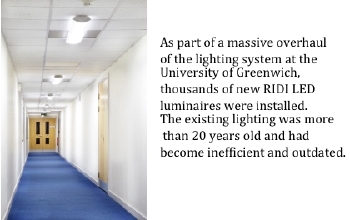Lighting the way to energy savings
With increasingly stringent regulations regarding building energy performance, LED lighting is often seen an easy way to get those energy bills down. But the latest lighting solutions can offer more than a simple quick fix — as Mike Attard of RIDI Lighting explains.
Legislation that comes into force in 2018 stipulates that it will be unlawful to let any residential or commercial building with an EPC (Energy Performance Certificate) of F or G. This means that a lot of building owners will be looking to save energy to improve their EPC rating. Upgrading a conventional lighting system to LED can provide a quick and easy way of reducing energy consumption that doesn’t require extensive construction work like, for example, replacing an HVAC system.
There are many variables that affect how much energy will be saved by replacing a traditional lighting system with LEDs — such as how much energy the existing system consumed, what lighting control is used and its operational hours.
A commonly used statistic is that an LED lighting installation could save 30 to 50% on electricity bills, which can make a huge difference to an organisation’s EPC. However careful design using fewer luminaires with a higher output can reduce installation costs, and this aspect should not be ignored.
There are also significant savings to be made in maintenance costs. There is no typical lifetime for an LED luminaire; operating conditions can have a big impact on a fixture’s longevity, but running for 10 h a day, one could expect a minimum of 30 000 h of usage, or just over eight years.
Compare that life expectancy to a fluorescent lamp, which on average will last for about 12 000 h, and you can immediately see there are significant savings to be made on manpower and buying replacements. For many organisations like airports or Transport for London, the maintenance aspect almost trumps the energy savings, because replacing a light fitting in high-ceilinged airport terminal or above an escalator is very costly.
Lumen depreciation is also a significant factor. In the main at RIDI we aim to produce a minimum of 80% of the light at 50 000 h (termed as L80). Lumen depreciation will be enhanced by good thermal management of the luminaire and careful handling of the LEDs to avoid any electrostatic discharge during production and installation.
 |
 |
More and more organisations are looking to boost their sustainability credentials, and part of that is generating as little waste as possible. Unfortunately, all too often when a component fails, the whole fitting is removed and disposed of, wasting a potentially perfectly good working product.
We build in serviceability into our products so that if a part does fail it can be quickly and easily replaced. We also guarantee provision of spare parts for 10 years after purchase, so that the lifetime of the luminaire can be significantly extended, creating a more sustainable solution. This policy makes maintaining a lighting installation much easier, as only parts of a luminaire have to be replaced rather than the entire fitting ; it also avoids mismatching of superseded models. All boards are produced in house and under our own control, so small-scale replacements can be economically produced.
When refurbishing a lighting installation with LED fittings, the temptation for many is to do a simple like-for-like retrofit. Swapping a standard fluorescent fixture for a low-cost LED panel for, example, will generate the energy and maintenance cost savings that are needed.
But refurbishment can mean so much more than a like-for-like replacement. It can be a great opportunity to refresh and redesign the lighting scheme, taking full advantage of the flexibility that LED lighting offers. It doesn’t have to be complicated, but it can make a huge difference to a building — whether it’s an office, a school or a hospital.
People appreciate good lighting, often subconsciously, and a well-designed lighting refurbishment using good-quality products can make a hugely positive impact on people’s appreciation of their environment.
The worst upgrades happen when older luminaires with good glare control and good balanced light distribution are replaced by sterile, flat LED products with little glare control. Office users will certainly know and comment when an installation is poor.
We work directly with many university estates departments and these people represent the toughest professional challenge. When selling into this sector, energy consumption is clearly very important, but maintenance, parts availability and producing sustainable products is equally important. Also, a product that will last in excess of 50 000 h with minimal depreciation is very important. Because they purchase, run and maintain the products, lowest purchase price is rarely the only determining factor. Whole-life costs clearly are, as is the sustainable message that goes with it is important.
The development of LED lighting represents a real opportunity for building managers to reduce their energy consumption, comply with legislation and significantly reduce their maintenance costs. It also enables more ambitious refurbishment projects that go beyond a straightforward retrofit and really enhance the people’s environment.
Mike Attard is managing director of RIDI Lighting.







